Last November, my partner and I embarked on a two-week road trip from Melbourne to the Blue Mountains in New South Wales. For 15 years, we had envisioned visiting the Blue Mountains, but various challenges such as financial constraints, bushfires, and floods in New South Wales had consistently prevented us from making the trip.
I initially found the accommodation we stayed at because it had a full kitchen, but my partner wanted to explore other options. The Blue Mountains can be quite pricey, especially for multi-night stays. Leisure Inn Spires was more affordable at $270 for two nights, while other places ranged from $411 to $2,420 for the same duration.
Nestled in the heart of the Blue Mountains, the Valley of the Waters is a breathtaking destination that captivates with its natural beauty. During my visit, I was amazed by the lush rainforest, cascading waterfalls, and the serene ambiance that surrounds this hidden gem. The walking trails offered stunning views of the valley, and the cool, misty air added to the experience. Whether you’re an avid hiker or simply looking to immerse yourself in nature, the Valley of the Waters is a must-see. Join me as I explore this enchanting corner of the Blue Mountains.
Key Ways to Travel Around the Blue Mountains
Travel Modes
Car
The most common way to reach the Blue Mountains is by car. The entrance at Glenbrook/Lapstone is just a 50-minute drive from Sydney. From the city, follow signs to Parramatta, then take the M4 Motorway from Strathfield directly to Lapstone in the Blue Mountains.
Another route is via Bell’s Line of Road, starting at Richmond and passing through Mount Tomah and Bell before arriving at Mount Victoria. This scenic drive through the expansive Blue Mountains National Park offers a charming alternative to the Great Western Highway. If you’re coming from the outer west, follow signs to Lithgow, continue to Hartley, and enter the Blue Mountains via Victoria Pass, which will take you directly to Mount Victoria.
I love driving around Australia because I have the flexibility to stop at places for as long as I like to enjoy each place and to capture it on camera and video.
Car Rental
Sydney Airport features several car rental companies located at the arrivals level of the T1 International and T2/T3 Domestic terminals. You can compare competitive rates from well-known providers such as Avis, Hertz, Europcar, Budget, Thrifty, and Enterprise.
Renting a car in Australia is quite straightforward. All you need is a valid Australian or international driver’s license and a credit or debit card.
Car rental prices can vary based on the company, vehicle type, and insurance options, so it’s wise to research and compare to find the best deal for your needs.
For additional information, click the link provided https://www.sydneyairport.com.au/info-sheet/rental-car
Train
One of the most leisurely ways to travel to the Blue Mountains is by train. Transport for NSW provides an efficient service to the area. If you’re arriving in Sydney, a rail link connects Sydney Airport directly to Central Railway Station. From there, you can board an air-conditioned double-decker train bound for the Blue Mountains. The journey typically includes stops at Strathfield, Parramatta, Penrith, Emu Plains, and various stations up the mountains. Most trains continue to Mount Victoria, with some extending to Lithgow. Trains generally run every hour, with increased service during peak times, and the trip takes about two hours via Trainlink. Before 9 a.m., trains depart every half hour from Sydney Central Station. Taxis are available at Blaxland, Springwood, Wentworth Falls, Leura, and Katoomba Railway Stations. You’ll need an Opal card to use the train network, which you can tap in and out with a credit or debit card.
Navigating the Blue Mountains without a car or tour can be challenging.
For details on the train timetable, click the provided linkhttps://transportnsw.info/#/
Coach
Several coach operators provide day trips to the Blue Mountains, generally departing from Circular Quay in Sydney. For information on recommended companies, tour options, and pricing, consult your travel agent or hotel. The coach journey usually takes between 3 and 5 hours to reach the Blue Mountains
Explore the list of companies https://www.bluemts.com.au/things-to-do/tours-to-the-blue-mountains/
Tours
If driving isn’t your preference, the most convenient way to explore the Blue Mountains is by taking a day trip tour. You can find relevant links in the Tours and Activities section further down in this blog post. Tours offer several advantages, including organized transportation, meals, and scheduled stops, as well as local insights from guides. They also provide opportunities to bypass lines at popular attractions, discover lesser-known spots with stunning views, and meet new people along the way.
Must-See Spots in the Blue Mountains
While the Blue Mountains can be visited throughout the year, the ideal time to go is when the weather is neither too hot nor too cold. Generally, the best experience is from September to October, during the spring months.
Summer Weather Conditions (December to February)
In Australia, summer spans from December to February, with average temperatures ranging from 22 to 30 degrees Celsius. The Lower Blue Mountains can experience even higher temperatures, occasionally exceeding these averages significantly. For instance, Penrith saw temperatures reach 40°C on multiple days during the summer of 2020, as reported by the Bureau of Meteorology.
If you enjoy warmer weather, summer is a great time to visit the Blue Mountains, although it is also the peak tourist season. The sunny weather is ideal for outdoor activities such as hiking, camping, bushwalking, and picnicking. To ensure a smooth trip and secure the best rates, it’s advisable to book your accommodations well in advance
Here are some activities to enjoy in the Blue Mountains during the summer:
- Hiking and Bushwalking: Explore popular trails like the Grand Canyon Walk, the Three Sisters Walk, and the Wentworth Falls track. Summer’s clear skies and extended daylight make for excellent hiking conditions.
- Picnicking: Enjoy a scenic picnic at spots like Echo Point, Scenic World, or the Blue Mountains Botanic Garden, which offer beautiful views and ample space for relaxation.
- Waterfalls and Scenic Views: Visit stunning waterfalls such as Katoomba Falls, Leura Cascades, and Bridal Veil Falls. The summer rains often enhance their flow and make for spectacular viewing.
- Adventure Activities: Try out adventurous activities like canyoning, abseiling, or mountain biking. The summer weather provides a perfect backdrop for these thrilling experiences.
- Scenic Rides: Take a ride on the Scenic Skyway or the Scenic Railway at Scenic World for breathtaking views of the mountains and valleys.
- Local Markets and Festivals: Explore local markets and seasonal festivals to experience the region’s culture and enjoy fresh produce and crafts.
- Wildlife Spotting: Summer is a great time to spot local wildlife, including birds, kangaroos, and other native animals in their natural habitat.
- Stargazing: The clear summer nights are ideal for stargazing. Find a quiet spot away from city lights to enjoy the night sky.
- Botanic Gardens: Visit the Blue Mountains Botanic Garden to see a variety of native plants in full bloom and enjoy a leisurely walk among the gardens.
- Relax and Unwind: Spend a day relaxing at one of the mountain lodges or resorts, enjoying the fresh air and stunning natural surroundings.
Autumn in the Blue Mountains – March to May
Autumn in the Blue Mountains, from March to May, is a spectacular time to visit. Temperatures typically range from 6°C to 18°C (43°F to 64°F), providing cool yet comfortable conditions for outdoor exploration. The landscape transforms into a tapestry of vibrant reds, oranges, and golds as the deciduous trees change color, offering stunning views and excellent photo opportunities. Popular spots like the Blue Mountains Botanic Garden and the lookouts at Echo Point and the Three Sisters are particularly picturesque during this season. The mild weather is ideal for hiking the numerous trails, including the scenic walks around Leura and Wentworth Falls. Autumn also brings fewer crowds compared to summer, allowing for a more peaceful experience. Overall, this season provides a beautiful backdrop for enjoying the natural beauty and tranquility of the Blue Mountains.
Here are some enjoyable activities to consider in the Blue Mountains during autumn:
- Leaf Peeping: Take in the stunning fall foliage by visiting scenic spots like the Blue Mountains Botanic Garden, Leura, and the lookout points around Katoomba and Wentworth Falls.
- Hiking and Bushwalking: Explore picturesque trails such as the Grand Canyon Walk, the National Pass, and the trails around the Megalong Valley, where autumn’s cooler temperatures make hiking more comfortable.
- Visit Local Markets: Enjoy the seasonal produce and crafts at local markets, such as the Leura Village Fair or the Katoomba Markets, which feature autumnal goods and regional specialties.
- Explore Gardens and Parks: Wander through the beautifully landscaped gardens and parks, including the Blue Mountains Botanic Garden and the Royal Botanic Garden at Mount Tomah, which are particularly vibrant during this time.
- Scenic Drives: Take a leisurely drive along the Great Western Highway or Bells Line of Road to admire the autumn colors and picturesque landscapes.
- Enjoy Cozy Cafés: Warm up with a hot drink or a seasonal treat at one of the charming cafés in towns like Leura or Katoomba, which offer a cozy atmosphere during the cooler months.
- Photography: Capture the stunning autumn scenery with your camera, from the colorful leaves to the misty mornings and panoramic views.
- Wildlife Spotting: Autumn is a good time for wildlife spotting, with cooler weather making animals more active. Look for kangaroos, birds, and other native wildlife in their natural habitat.
- Visit Historical Sites: Explore local historical sites and museums, such as the Blue Mountains Heritage Centre or the Mount Victoria Historical Museum, to learn more about the region’s history and culture.
- Relax and Unwind: Enjoy a peaceful retreat in one of the region’s lodges or resorts, where you can relax by a fire, take in the autumn scenery, and rejuvenate in a tranquil setting.
Winter Season – June to August
Winter in the Blue Mountains, from June to August, offers a magical experience with its crisp air and occasional frost. Temperatures typically range from 1°C to 11°C (34°F to 52°F), creating a serene atmosphere ideal for cozying up in a mountain lodge or enjoying a hot drink by a fire. The winter months also bring a chance to witness the occasional snowfall, transforming the landscape into a picturesque winter wonderland. This season is perfect for exploring the region’s scenic trails with fewer crowds, including popular hikes like the Six Foot Track or the trails around Leura and Wentworth Falls. Winter is also a great time for wildlife spotting, as the cooler weather makes animals more visible. The charming towns of Katoomba and Leura are particularly inviting, with their quaint shops and cafés offering warmth and comfort. Overall, winter in the Blue Mountains provides a unique blend of tranquility, scenic beauty, and cozy experiences.
Here are some enjoyable activities to experience in the Blue Mountains during winter:
- Snow and Ice Scenery: Explore the occasional snowfall and frosty landscapes. Visit areas like Mount Victoria and the Blue Mountains Botanic Garden to see the region’s winter beauty.
- Hiking and Bushwalking: Enjoy cooler temperatures and fewer crowds on popular trails such as the Six Foot Track, the Grand Canyon Walk, and the trails around Wentworth Falls and Leura.
- Visit Scenic Lookouts: Take in the breathtaking winter views from lookouts like Echo Point and the Three Sisters. The clear winter air often provides excellent visibility.
- Wildlife Spotting: Look for wildlife, including kangaroos, wallabies, and various bird species, which can be more visible against the winter backdrop.
- Explore Towns and Villages: Discover the charm of the Blue Mountains’ towns like Katoomba and Leura. Enjoy their cozy cafés, local shops, and warm hospitality.
- Stay in a Lodge or Cabin: Relax in a cozy lodge or cabin with a fireplace. Many accommodations offer winter specials and packages.
- Visit Local Markets: Explore local markets, such as the Katoomba or Leura Markets, where you can find winter produce, crafts, and unique gifts.
- Take a Scenic Drive: Enjoy a scenic drive through the Blue Mountains, including routes like the Great Western Highway and Bells Line of Road, which offer picturesque winter views.
- Visit Historical Sites: Explore the region’s historical sites and museums, such as the Blue Mountains Heritage Centre or the Mount Victoria Historical Museum, to learn more about the area’s history and culture.
- Attend Winter Events: Check for local winter events and festivals, which may include seasonal activities, performances, and community gatherings.
Winter in the Blue Mountains offers a blend of tranquility, scenic beauty, and cozy experiences perfect for a memorable getaway.
Springtime in the Blue Mountains, NSW
Spring in the Blue Mountains, from September to November, is a delightful time to visit, with temperatures ranging from 8°C to 22°C (46°F to 72°F). This season brings a refreshing change as the landscape comes alive with blooming wildflowers and lush greenery. The cooler mornings and mild afternoons create perfect conditions for outdoor activities such as hiking, bushwalking, and exploring the region’s scenic lookouts. Popular spots like the Blue Mountains Botanic Garden and the various nature reserves showcase vibrant displays of color and new growth. Spring also offers fewer tourists compared to the summer months, providing a more peaceful and enjoyable experience. Overall, this season is ideal for appreciating the natural beauty and tranquility of the Blue Mountains as it emerges from winter.
Spring in the Blue Mountains offers a variety of activities to enjoy the season’s beauty and mild weather:
- Wildflower Viewing: Explore the blooming wildflowers throughout the region. Visit the Blue Mountains Botanic Garden at Mount Tomah for a spectacular display of spring flora.
- Hiking and Bushwalking: Take advantage of the pleasant weather by hiking popular trails such as the Grand Canyon Walk, the National Pass, and the trails around Wentworth Falls and Leura.
- Scenic Lookouts: Enjoy the clear spring skies and vibrant views from lookouts like Echo Point, the Three Sisters, and Scenic World.
- Explore Gardens and Parks: Wander through the Blue Mountains Botanic Garden, or visit local parks and gardens in towns like Leura and Katoomba to see the seasonal blooms.
- Wildlife Spotting: Spring is a great time to observe wildlife as animals become more active. Look out for kangaroos, wallabies, and various bird species.
- Visit Local Markets: Check out local markets such as the Katoomba or Leura Markets for fresh produce, crafts, and unique souvenirs.
- Picnicking: Enjoy a picnic in one of the many scenic spots or parks. The pleasant spring weather makes for a perfect outdoor dining experience.
- Scenic Drives: Take a leisurely drive through the Blue Mountains to appreciate the changing scenery and vibrant colors of spring.
- Photography: Capture the beauty of the season with photography, from wildflower close-ups to panoramic landscape shots.
- Attend Local Events: Look for spring festivals and events in the area, which may include outdoor concerts, art exhibitions, and community gatherings.
Spring in the Blue Mountains offers a refreshing and scenic backdrop for enjoying nature and outdoor activities.
Exploring the Valley of the Waters in the Blue Mountains
The Blue Mountains are a treasure trove of natural wonders, but few places within this region offer the sheer magic and serenity of the Valley of the Waters. This picturesque valley is tucked away in the heart of the Blue Mountains National Park, and it’s a destination that should be on every nature lover’s list. From its cascading waterfalls to the dense, ancient rainforest, the Valley of the Waters is a haven of tranquility and beauty.
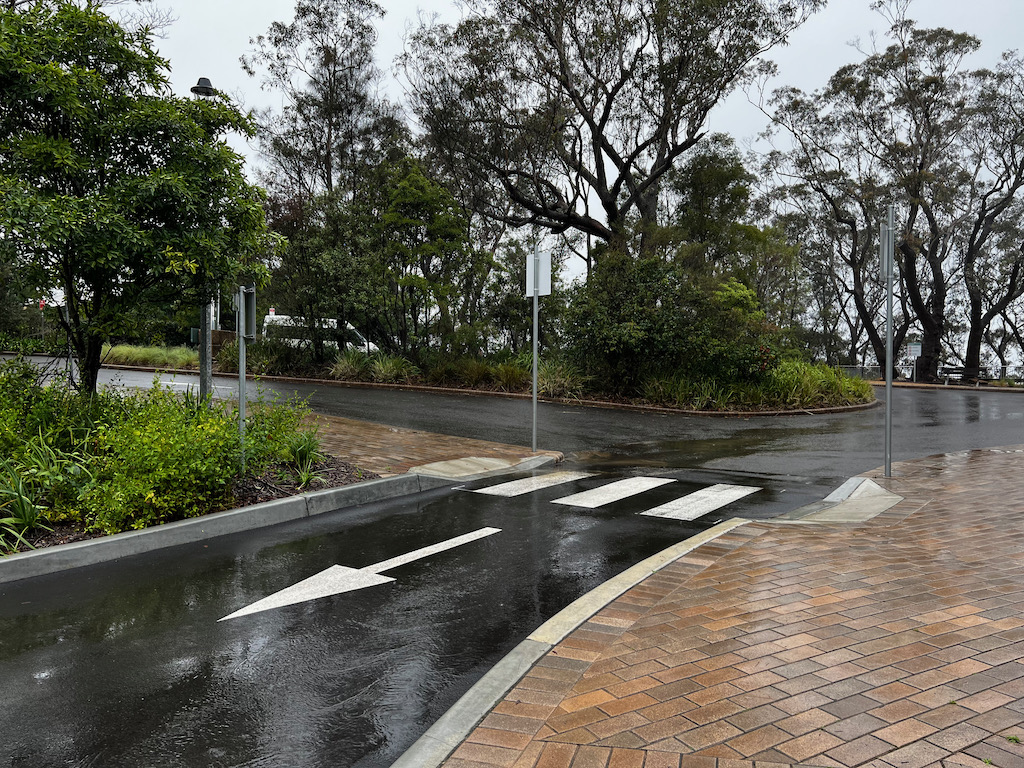
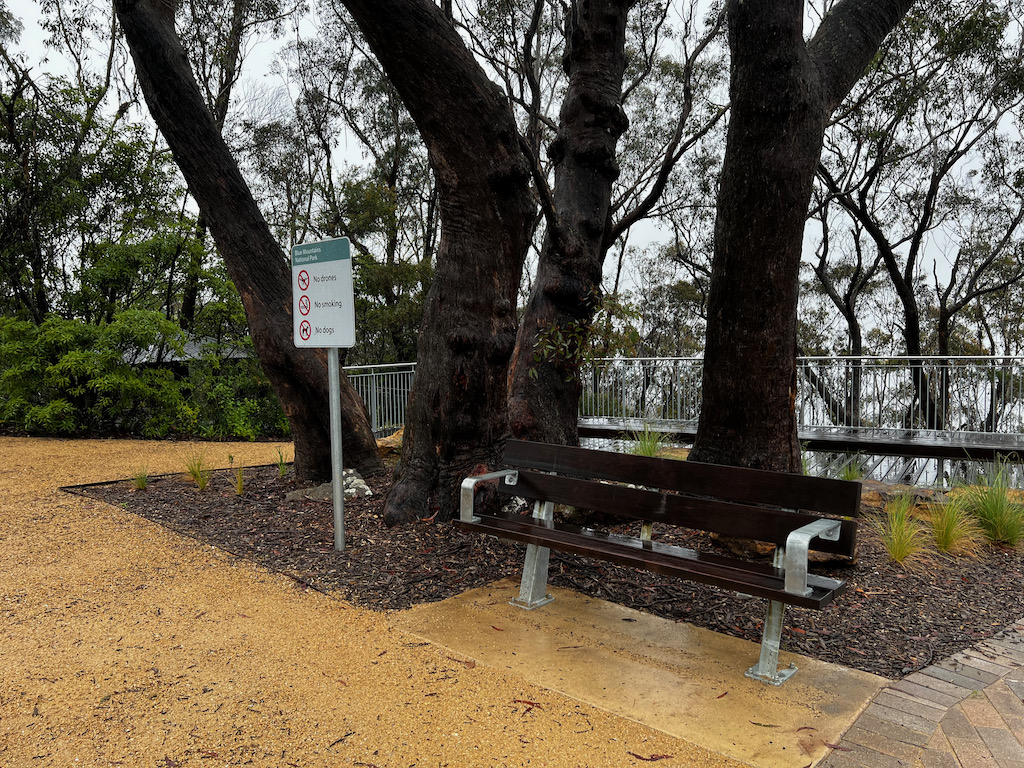
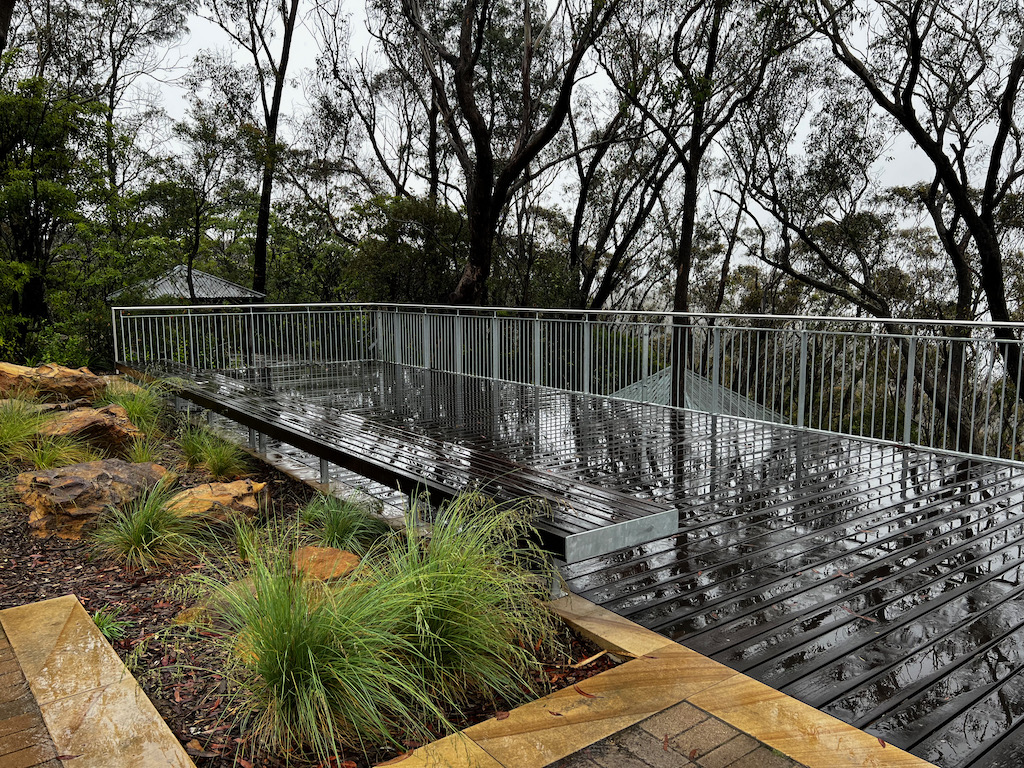


Getting There
Located near the charming village of Wentworth Falls, the Valley of the Waters is easily accessible by car. From Sydney, it’s about a 90-minute drive along the Great Western Highway. Once you arrive in Wentworth Falls, follow the signs to the Valley of the Waters, and you’ll find yourself at the start of an unforgettable journey into the heart of nature.
The Walking Tracks
The Valley of the Waters is home to several walking tracks, each offering its own unique experience. One of the most popular is the National Pass, a moderate to challenging track that takes you along the cliffs and down into the valley itself. This walk provides breathtaking views of the surrounding mountains and valleys, and you’ll pass by some of the most stunning waterfalls in the region, including Empress Falls, Sylvia Falls, and Lodore Falls.
If you’re looking for something a bit less strenuous, the Valley of the Waters Track is a shorter walk that still allows you to experience the beauty of the area. This track takes you past the Empress Falls and offers numerous opportunities to stop and take in the scenery. The sound of the waterfalls and the sight of the lush vegetation make this walk a truly immersive experience.
On the 25th November 2023 we did the Wentworth Falls walk in the morning and then went back to our accommodation to have lunch. After lunch we headed to the Valley Of The Water track, we arrived at 3:25pm and started walking the track, we passed people who had either been abseiling, rock climbing, canyoning or caving on our way down. Expect delays at exit abseil in peak season, with guided tours operating from 12pm to 2:30pm from October to April. Flood events occur during and following heavy rain
The track was wet and it slowed me down because I was more cautious about slipping, it was even harder walking down the steep step staircases as it was easy to slip and fall down. By 4pm it had started to rain, so we decided it wasn’t safe to continue and headed back to the car.
We decided to let the track dry out so we didn’t go back the next day and did others walks instead. On the 27th November 2023 we headed back to do the Valley Of The Waters walk. It was so much easier to walk the track when it wasn’t wet and it was a nice sunny day so we had nice views at the lookouts, where the first time we had low clouds blocking the views. It was amazing seeing the views on 2 different days with totally different photos.
I would definitely recommend this walk if you love visiting waterfalls like we do, on this track there are about 7 waterfalls that you walk past, but we only got to see the first two which were very impressive in there size and how much water was flowing over them because the track was closed after the second waterfall as there had been a lot of rain that had damaged the track.
Penalties apply if you ignore the blocked off track as it is closed for your safety.
Be careful and obey the sign that says unstable edges and slippery surfaces, the creek line environs are very slippery. There is risk of significant falls if you leave the track here.
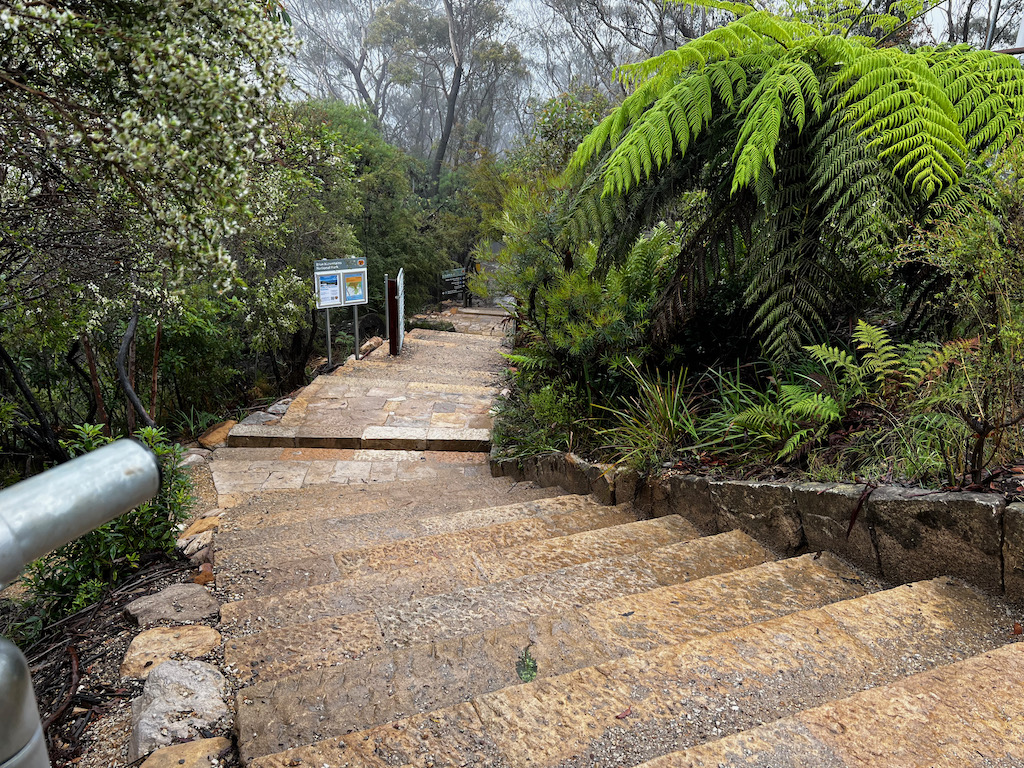
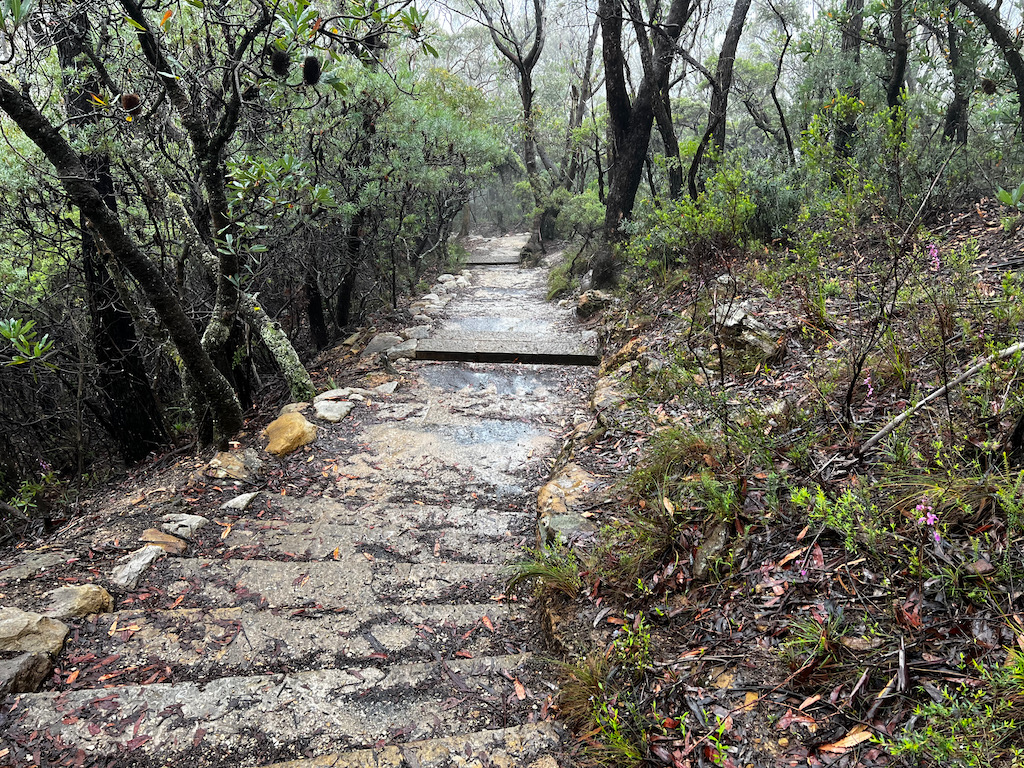

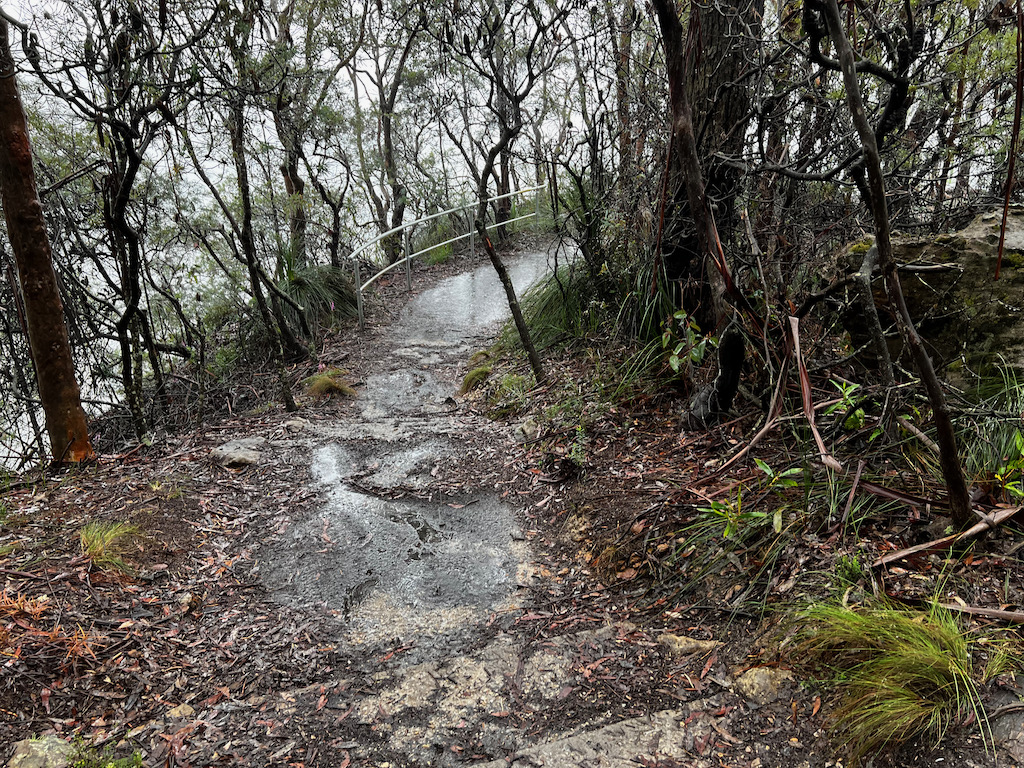
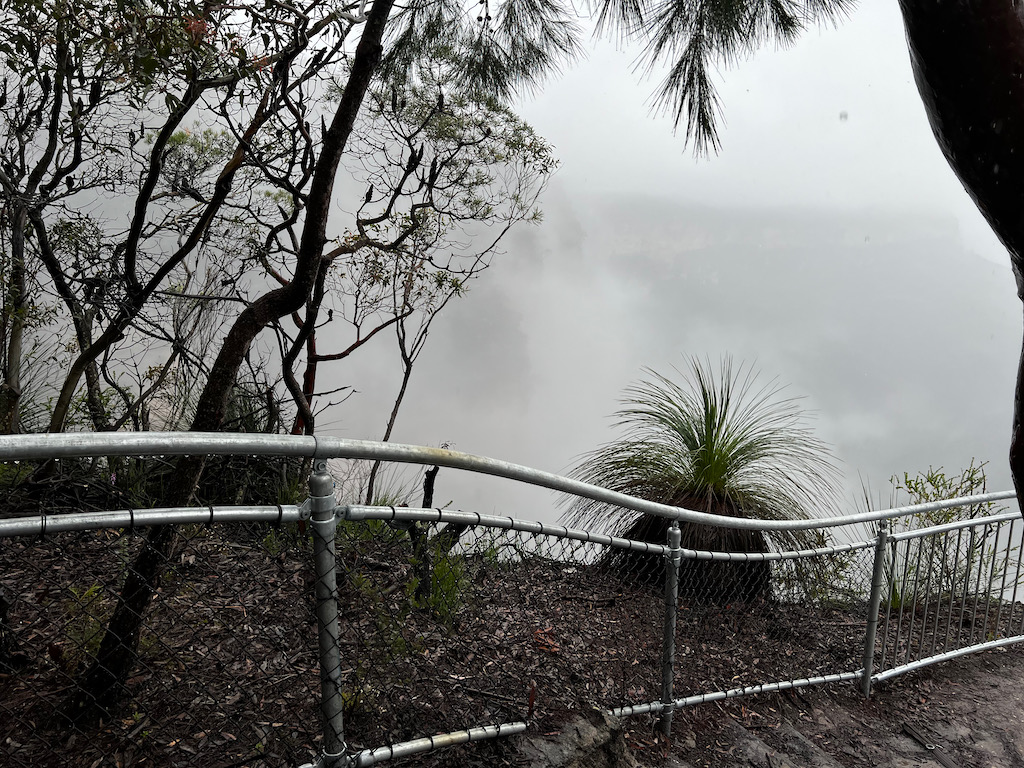

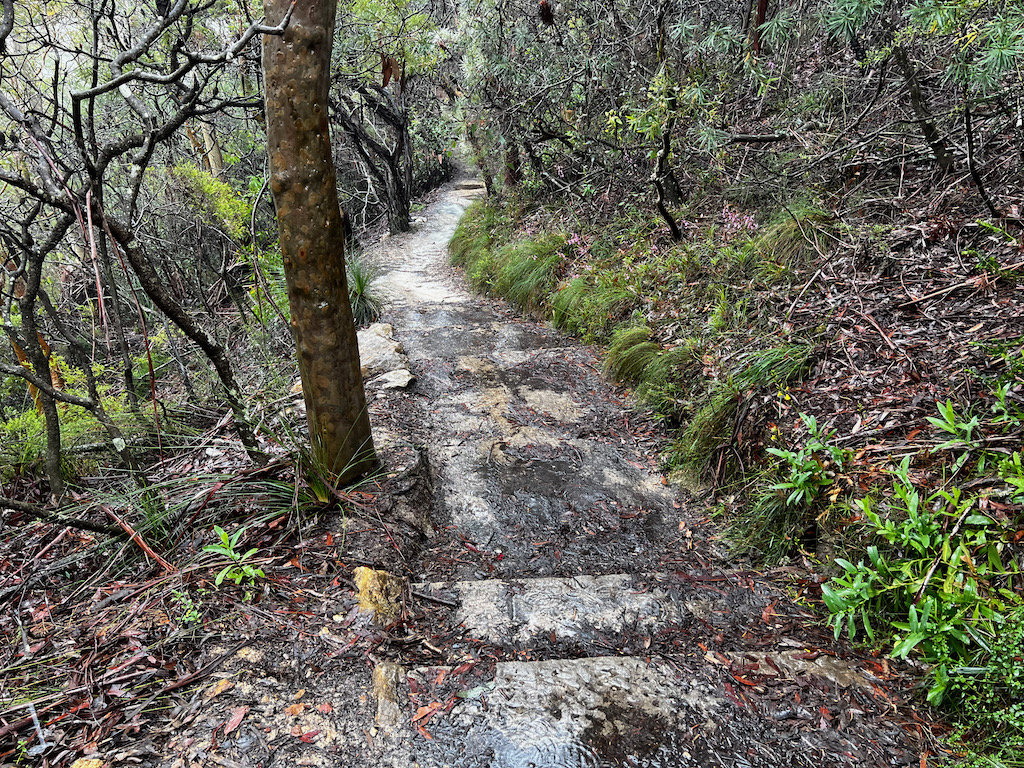


Be care full when walking along the steep sections as there is a tv show called Police Rescue in Australia where they show how they rescue people from the Blue Mountains when they get injured and can’t walk out. Depending on your injury they can either walk you out on a stokes basket with terrain wheels or fly you out with a helicopter but it takes hours either way. Always be prepared with enough water, the right shoes, sunscreen, hat and don’t forget to take a camera and have your phone fully charged and check the weather forecast before walking because the weather can change quickly in the Blue Mountains.
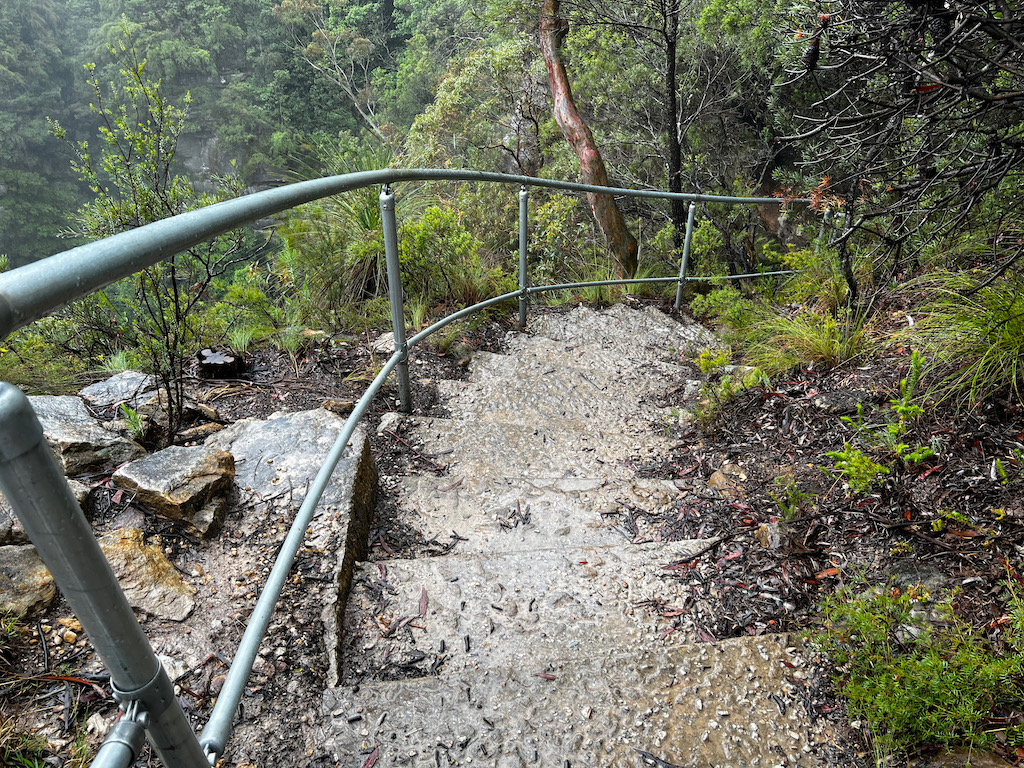


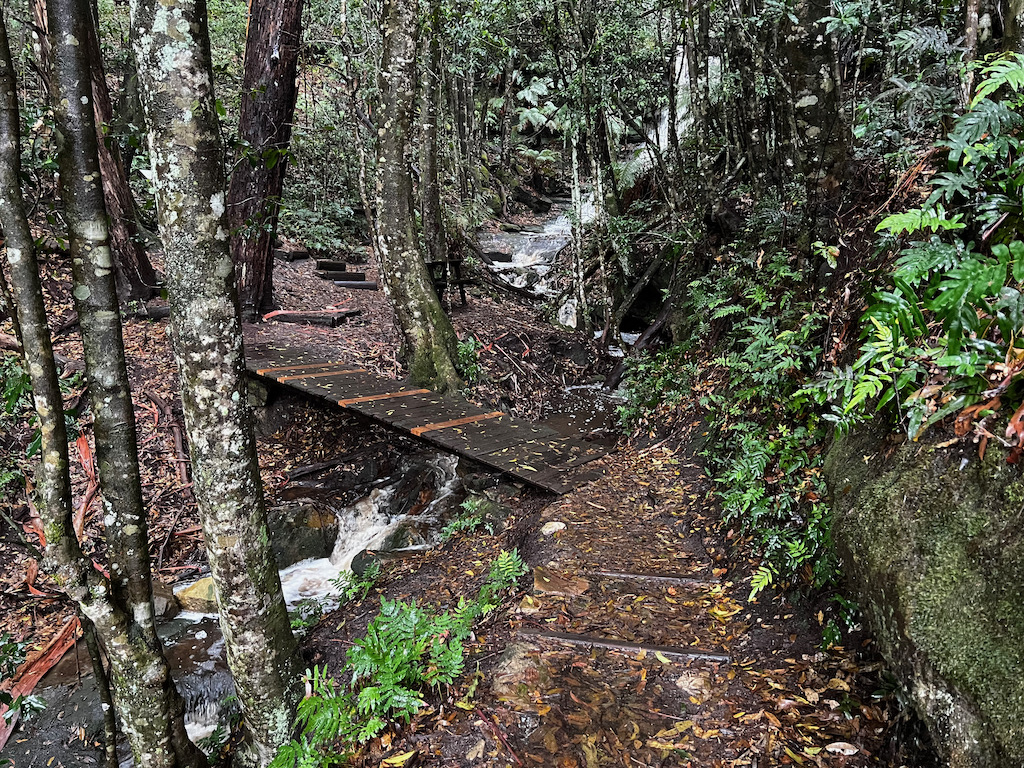
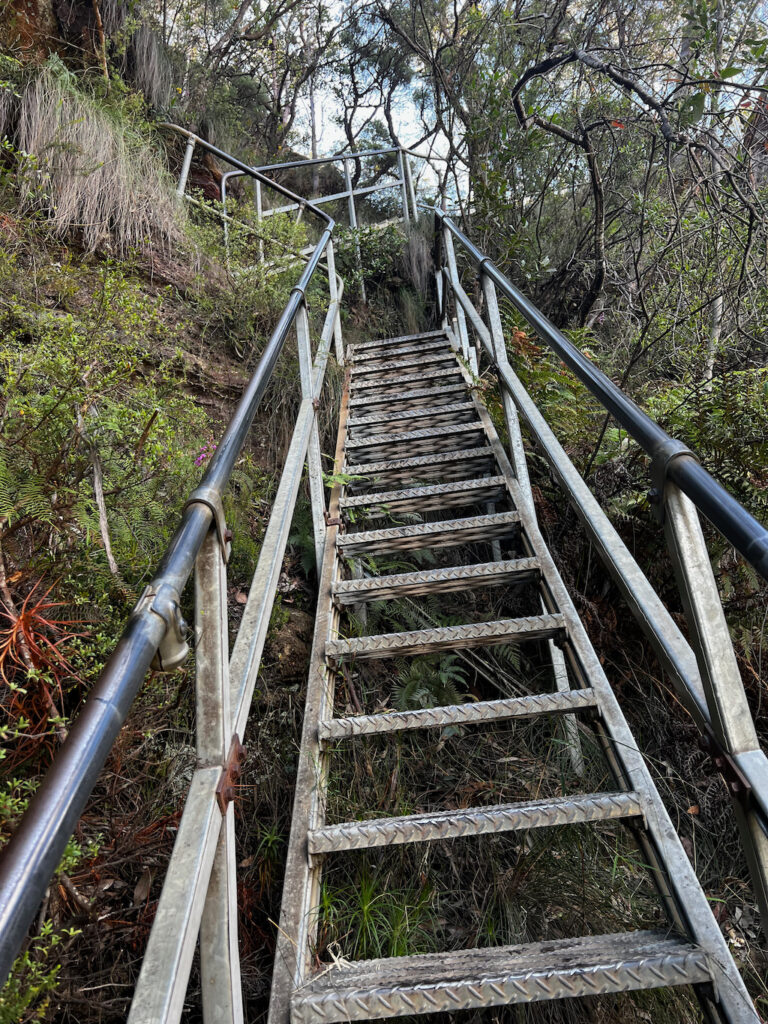
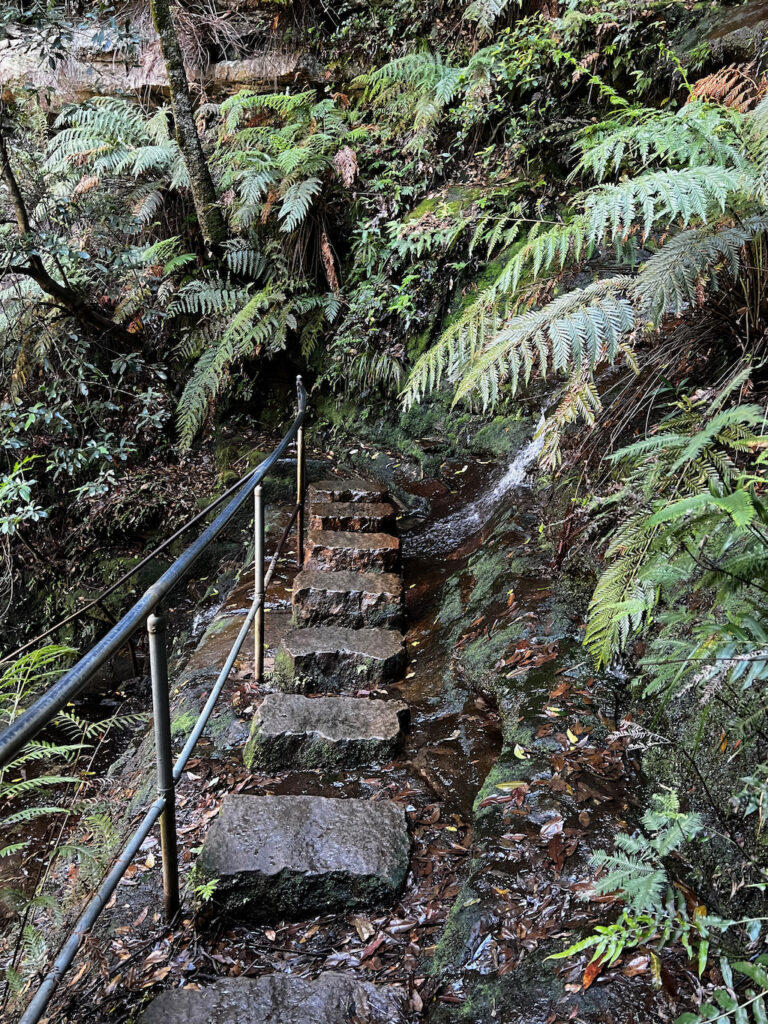
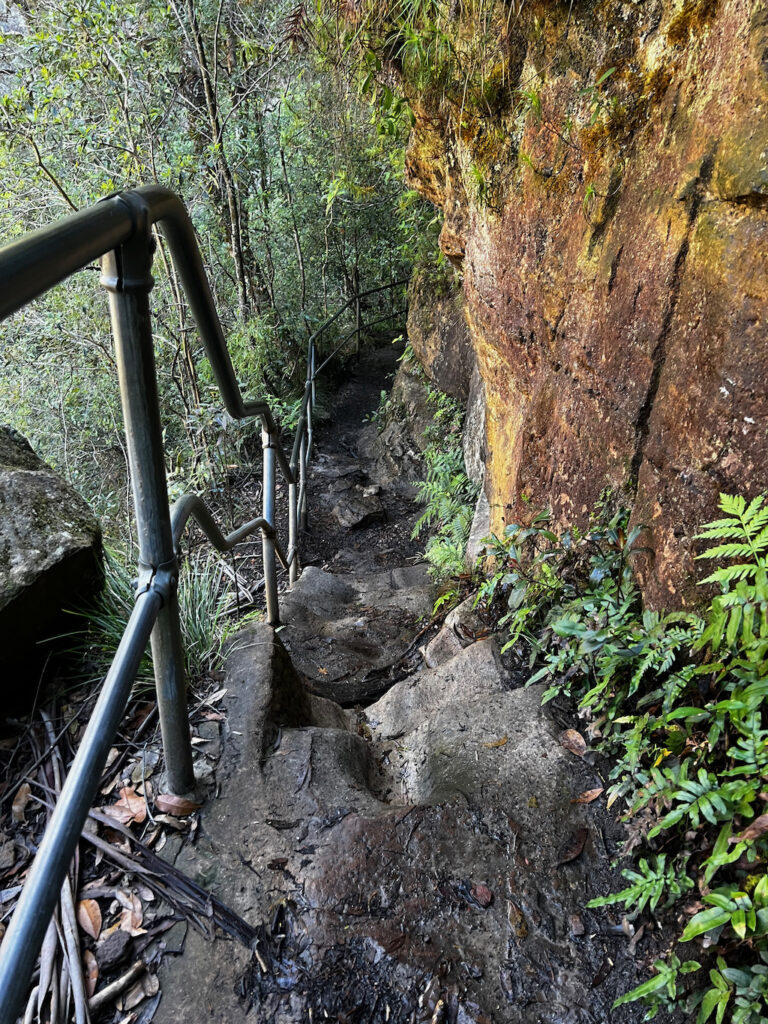
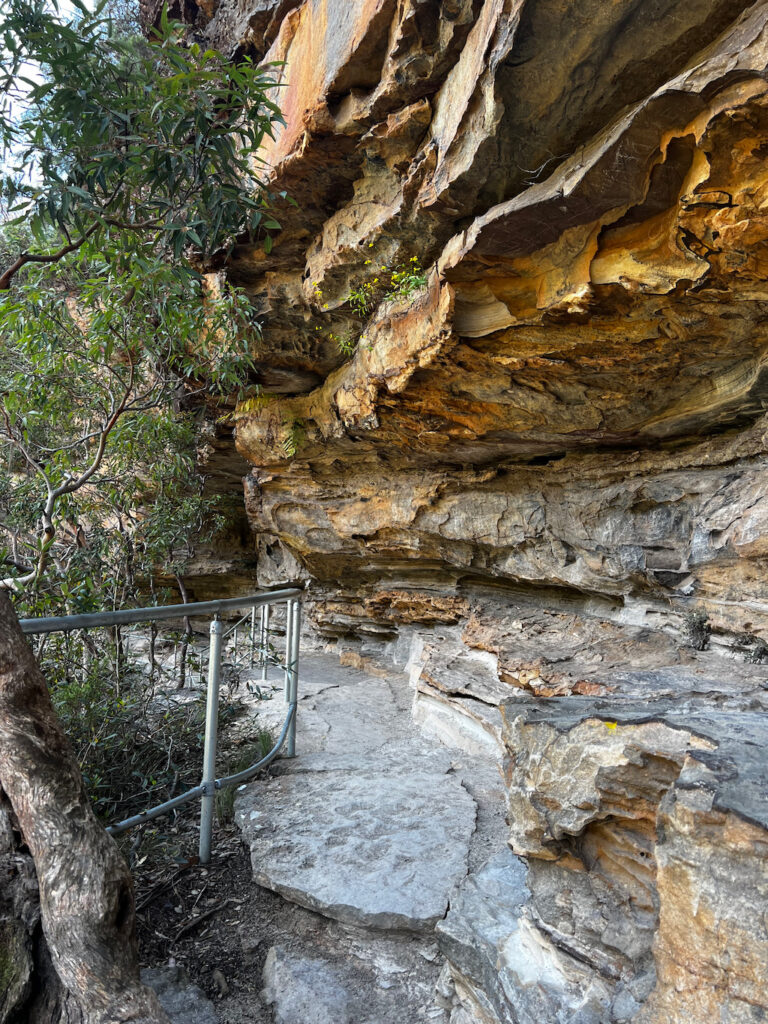
The Waterfalls
The waterfalls in the Valley of the Waters are the true highlights of this area. Empress Falls is perhaps the most famous, with its powerful cascade of water plunging into a deep, cool pool below. Sylvia Falls, located just a short distance away, is equally stunning, with multiple tiers of water flowing gracefully over moss-covered rocks. Each waterfall has its own charm, and it’s easy to spend hours exploring and photographing these natural wonders.
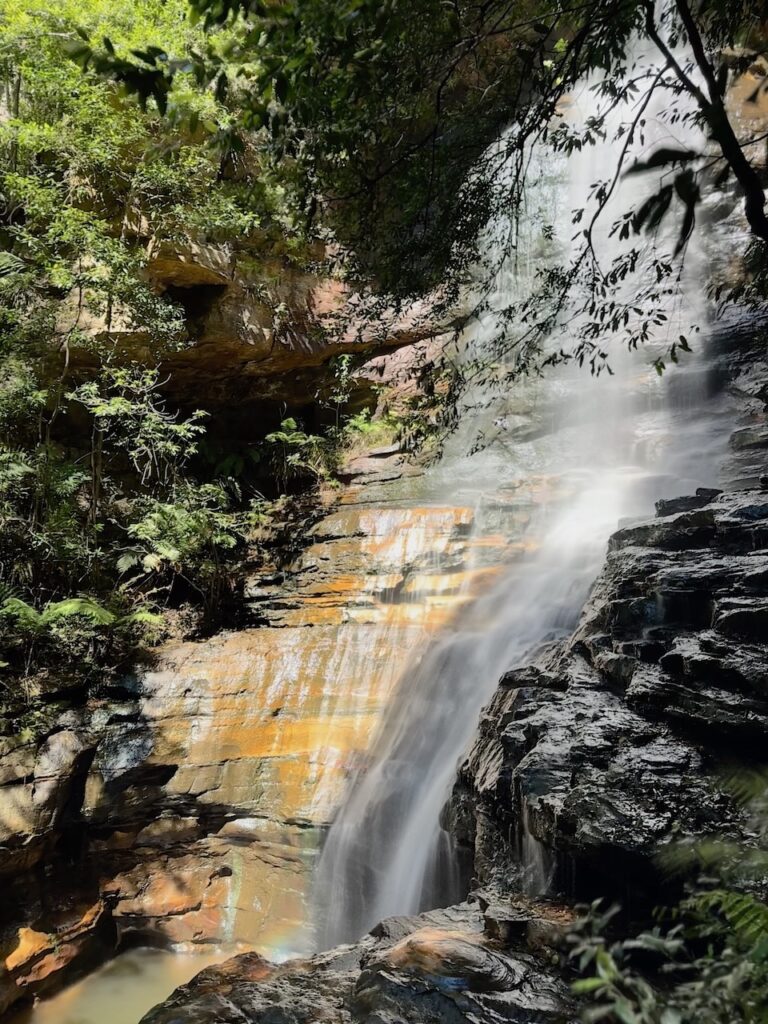
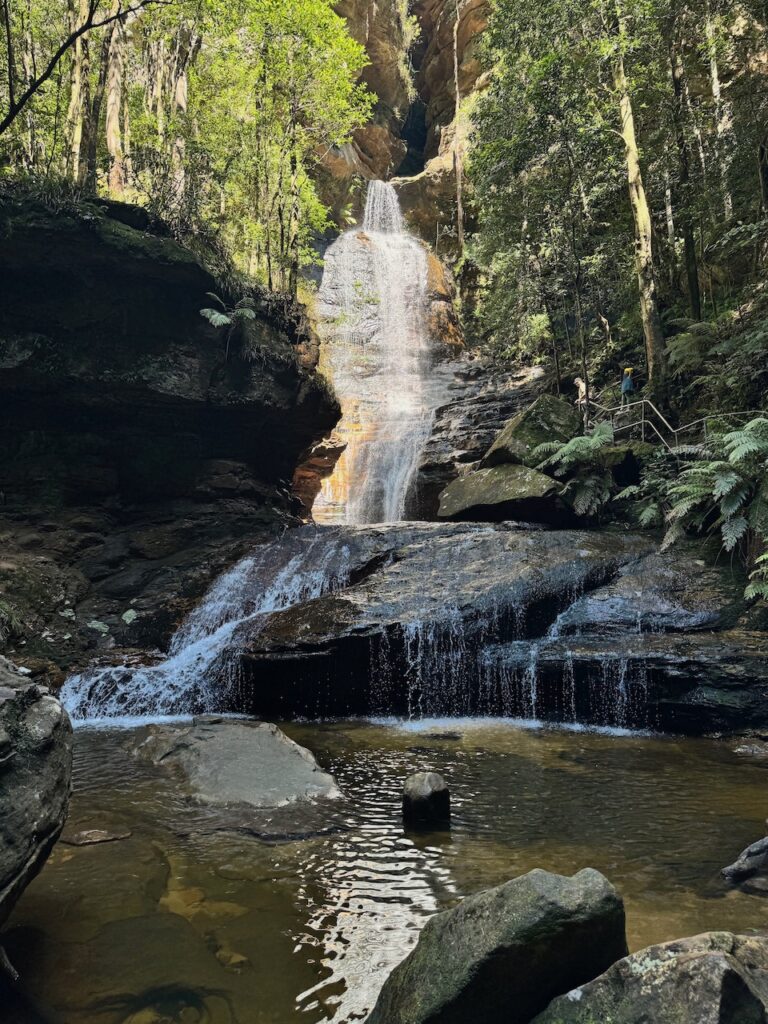
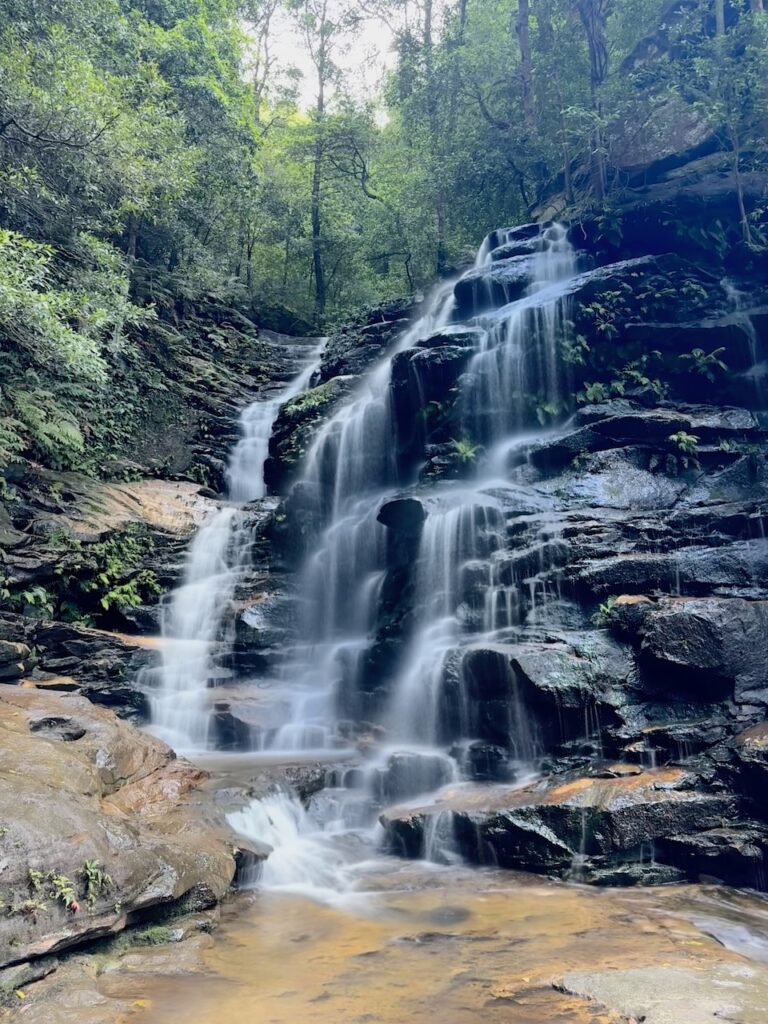
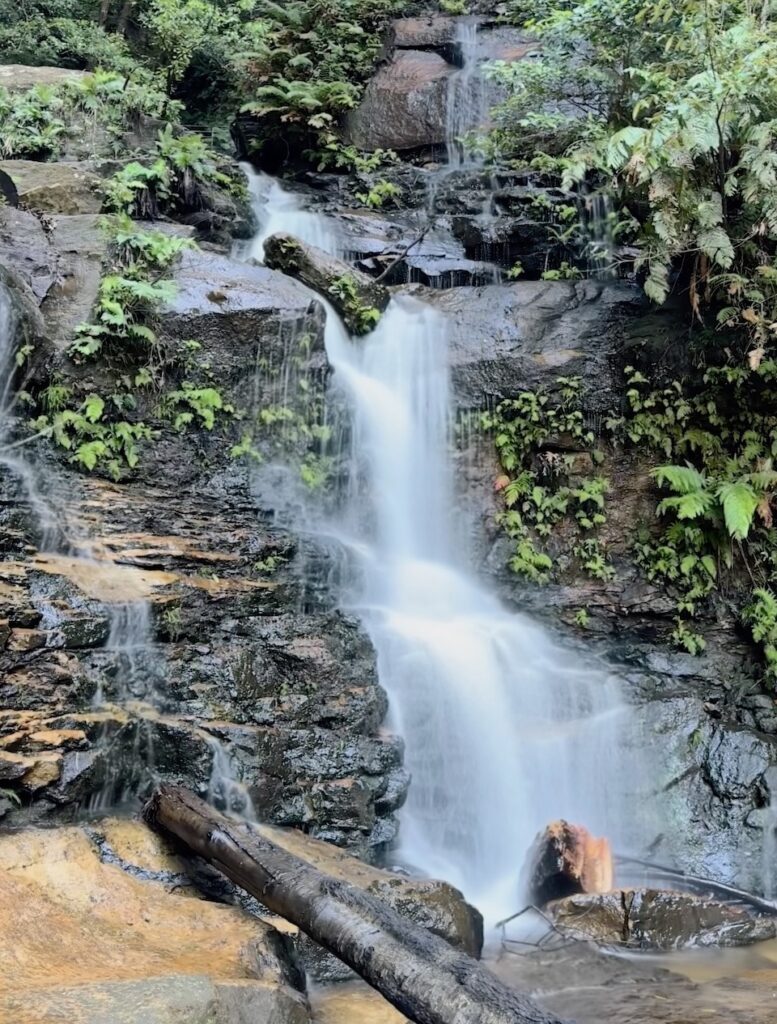
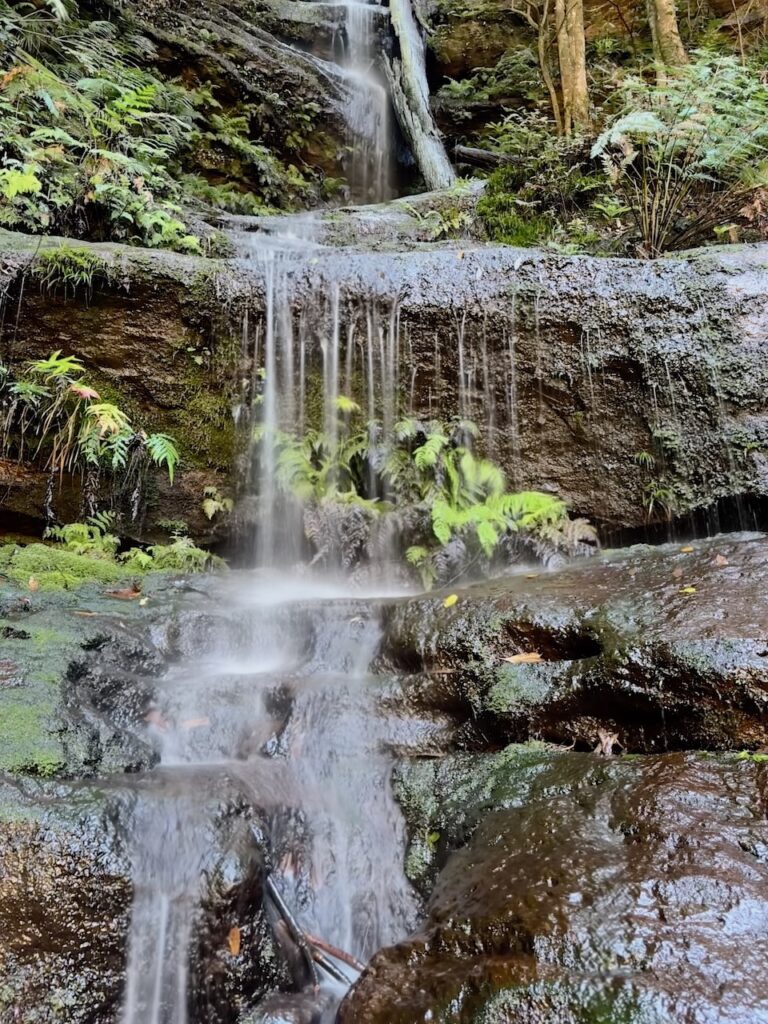
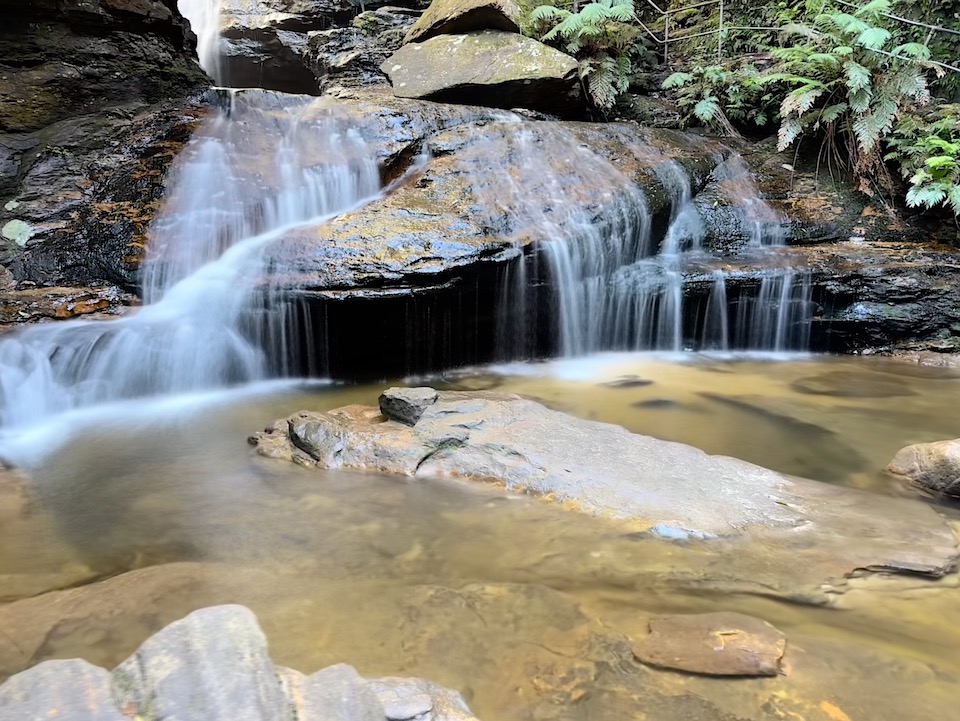
Flora and Fauna
As you walk through the Valley of the Waters, you’ll be surrounded by a vibrant ecosystem. The rainforest is home to a diverse range of plants and animals, from towering eucalypts and ferns to colorful parrots and lyrebirds. Keep an eye out for the unique rock formations and the many varieties of wildflowers that bloom throughout the year.
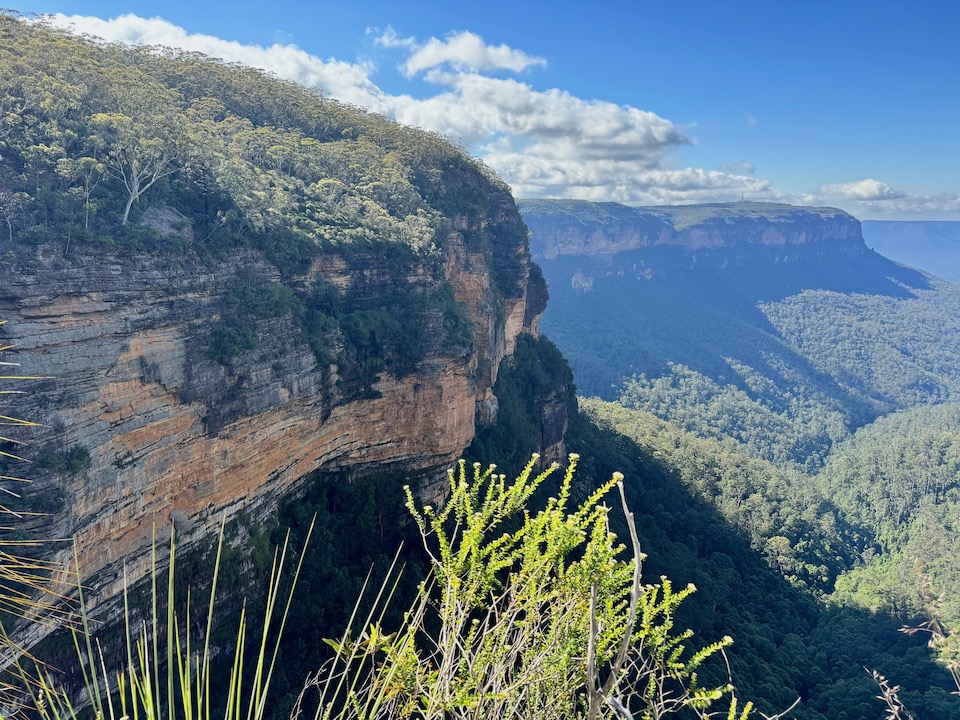

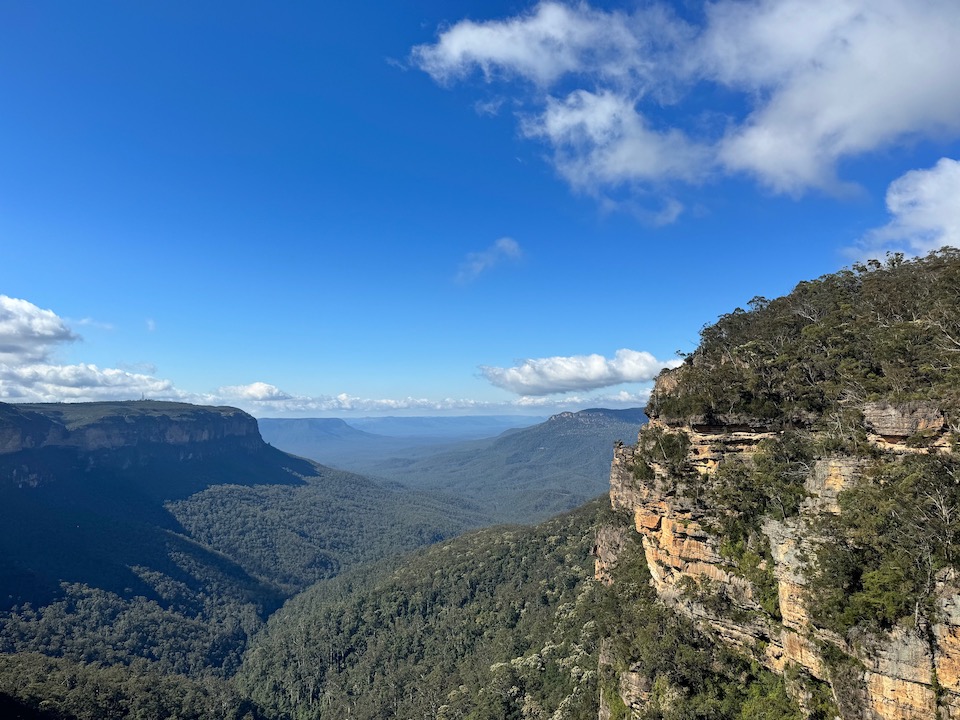
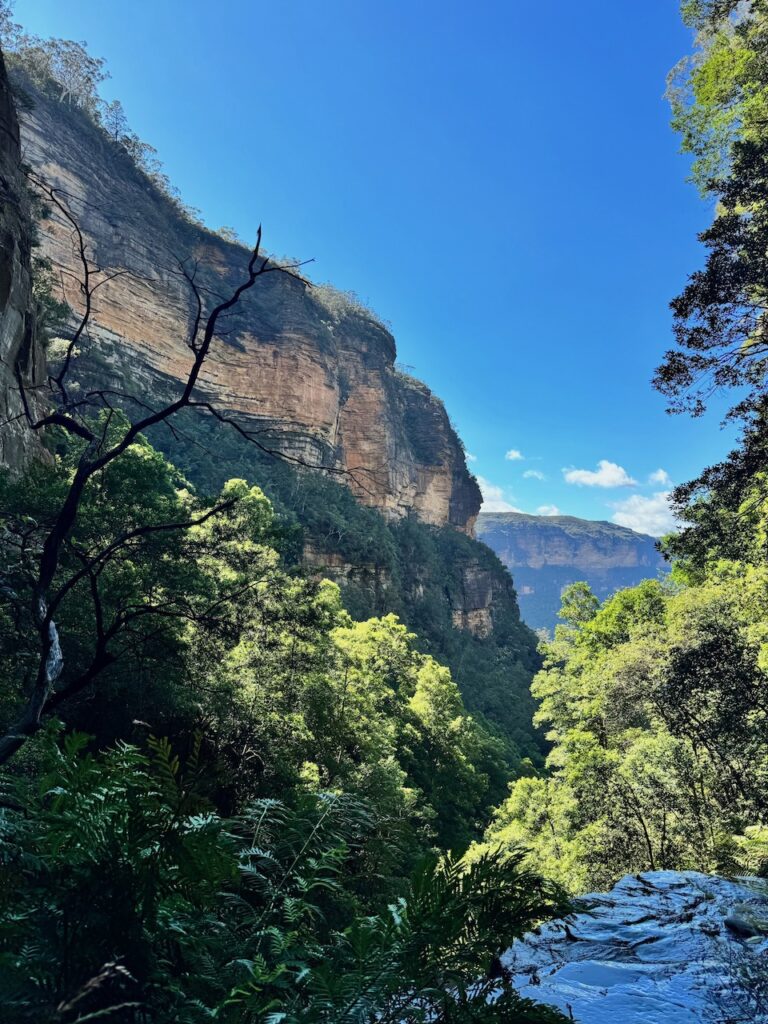

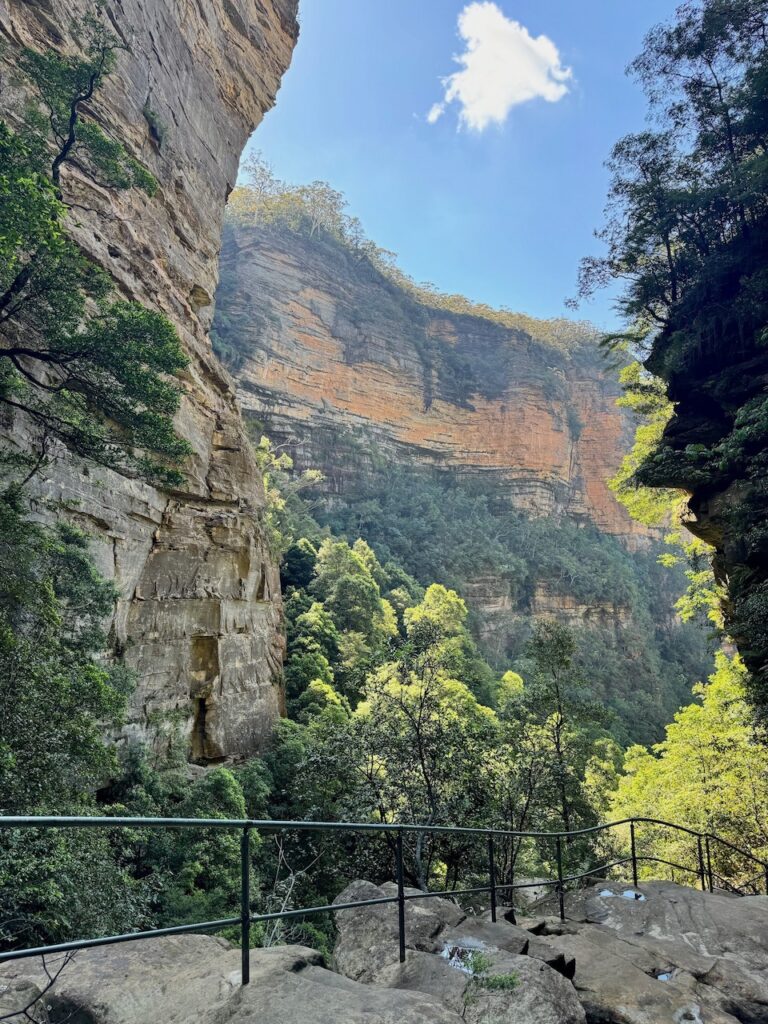
Tips for Visiting
- Wear comfortable walking shoes: The tracks can be steep and uneven in places, so sturdy footwear is essential.
- Bring water and snacks: While the walks aren’t too long, it’s always a good idea to stay hydrated and energized, especially if you’re planning to explore multiple tracks.
- Be mindful of the weather: The Blue Mountains can experience sudden changes in weather, so bring layers and be prepared for cooler temperatures, especially in the early morning or late afternoon.
Final Thoughts
The Valley of the Waters is a true gem of the Blue Mountains, offering visitors a chance to connect with nature in a peaceful and awe-inspiring setting. Whether you’re an experienced hiker or just looking for a scenic escape, this area has something for everyone. So pack your walking shoes, grab your camera, and get ready to explore one of the most beautiful corners of the Blue Mountains.
Must-See Spots in the Blue Mountains
Mount Blackheath Lookout
Mount Blackheath Lookout, nestled in the heart of the Blue Mountains, offers stunning views of the Kanimbla Valley and the surrounding escarpments. This serene spot is a favorite among paragliders and hang gliders, who take advantage of the ideal launch conditions provided by the high vantage point. Visitors can enjoy the peaceful atmosphere while soaking in the sweeping vistas, particularly during sunset when the landscape is bathed in warm, golden light. The lookout is easily accessible by a short drive from Blackheath, and it’s a perfect place for a picnic or a quiet moment of reflection in nature.
For more details, click the link provided.https://www.nsw.gov.au/visiting-and-exploring-nsw/locations-and-attractions/mount-blackheath-lookout
Hargraves Lookout
Hargraves Lookout, located near Blackheath in the Blue Mountains, offers panoramic views of the Megalong Valley and beyond. Perched on a dramatic cliff edge, this lookout provides an unobstructed vista of the valley’s rolling hills, dense forests, and distant peaks. It’s a fantastic spot for watching the sunrise or sunset, as the changing light transforms the landscape into a tapestry of colors. The lookout is accessible via a short drive from Blackheath, followed by a short walk, making it an ideal destination for those seeking a peaceful escape with breathtaking scenery. The area is also popular for picnics, photography, and simply soaking in the natural beauty of the Blue Mountains
For additional information, click the provided link. https://www.nsw.gov.au/visiting-and-exploring-nsw/locations-and-attractions/hargraves-lookout
Evans lookout
Evans Lookout, situated near Blackheath in the Blue Mountains, provides stunning views of the Grose Valley. From this vantage point, visitors can marvel at the vast expanse of lush wilderness, deep gorges, and rugged cliffs that define the valley. The lookout is renowned for its breathtaking vistas, especially at sunrise and sunset when the light casts a golden hue over the landscape. Accessible via a short, easy walk from the car park, Evans Lookout is a popular spot for both casual visitors and avid photographers. Its serene setting and impressive views make it a must-visit destination for anyone exploring the Blue Mountains.
For more information click on the link provided https://www.nationalparks.nsw.gov.au/things-to-do/lookouts/evans-lookout
Cliff Top walking track
The Cliff Top Walking Track is a captivating trail in the Blue Mountains that offers breathtaking views of the surrounding landscape. This moderate-grade hike meanders along the edge of the cliff, providing panoramic vistas of the rugged valleys and distant mountains. The track begins at the Evans Lookout car park and leads hikers through lush vegetation and unique rock formations. As you follow the path, you’ll encounter several scenic viewpoints, perfect for photo opportunities. The trail is approximately 6.5 kilometers long and typically takes around 2 to 3 hours to complete, offering a rewarding experience for those who enjoy both natural beauty and a bit of adventure.
For further information, click the link provided.. https://www.nationalparks.nsw.gov.au/things-to-do/walking-tracks/cliff-top-walking-track
Govetts Leap lookout
Govetts Leap Lookout is a stunning vantage point in the Blue Mountains, renowned for its dramatic views of the Grose Valley. From this lookout, visitors are treated to a breathtaking panorama of cascading waterfalls, verdant forests, and steep cliffs. The lookout provides a perfect view of the impressive Govetts Leap Falls, which plunge over the escarpment into the valley below. Accessible via a short walk from the car park, this viewpoint is ideal for those seeking to capture the majestic beauty of the Blue Mountains in a single glance. The lookout offers a tranquil spot to appreciate the natural splendor and is a must-visit for nature enthusiasts and photographers alike.
For more information, click the link provided. https://www.nationalparks.nsw.gov.au/things-to-do/lookouts/govetts-leap-lookout
Blackheath Lookouts Driving Route
The Blackheath Lookouts Driving Route is a scenic journey through the Blue Mountains, offering breathtaking views from several key vantage points. Starting in Blackheath, this route takes you to some of the region’s most iconic lookouts, including Govetts Leap, which provides stunning vistas of the Grose Valley and its cascading waterfalls. As you drive along, you’ll encounter other scenic spots like Evans Lookout and the lush landscapes surrounding them. This driving route is perfect for those wanting to experience the diverse beauty of the Blue Mountains from the comfort of their vehicle, with ample opportunities for photo stops and short walks to enhance your visit.
For additional information, click the provided link. https://www.nationalparks.nsw.gov.au/things-to-do/driving-routes/blackheath-lookouts-driving-route
Fairfax Heritage walking track
The Fairfax Heritage Walking Track is a captivating trail that winds through the lush landscapes of the Blue Mountains, offering hikers a glimpse into the region’s natural and cultural heritage. This 8.5-kilometer track, rated as moderate, begins at the Glenbrook Visitor Centre and follows a scenic route along the picturesque Nepean River. As you traverse the track, you’ll be treated to views of dense eucalyptus forests, charming creeks, and historical landmarks that highlight the area’s rich indigenous and colonial history. The trail is well-marked and includes informative signs that provide insights into the local flora and fauna, making it an enriching experience for nature lovers and history enthusiasts alike.
For more information click on the link provided https://www.nationalparks.nsw.gov.au/things-to-do/walking-tracks/fairfax-heritage-walking-track
Perrys Lookdown
Perrys Lookdown is a spectacular vantage point in the Blue Mountains that offers breathtaking views over the expansive Grose Valley. This lookout, accessible via a short but steep walk, provides panoramic vistas of rugged cliffs, lush forested valleys, and the serene, winding river below. The lookout is known for its tranquil setting and is an ideal spot for those looking to immerse themselves in the natural beauty of the region. The area is perfect for a peaceful break or a photography session, capturing the stunning contrasts of the verdant valley against the dramatic escarpments. With its relatively easy access and rewarding views, Perrys Lookdown is a must-visit for anyone exploring the Blue Mountains.
For more details, click the link provided. https://www.nationalparks.nsw.gov.au/things-to-do/lookouts/perrys-lookdown
Sublime Point lookout – Leura
Sublime Point Lookout in Leura is renowned for its stunning and expansive views of the Blue Mountains. Perched high above the valleys, this lookout offers a breathtaking panorama that includes the rugged cliffs, lush forests, and the serene depths of the Jamison Valley. The lookout is easily accessible via a short, scenic walk, making it an ideal spot for visitors looking to experience the natural grandeur of the region without a strenuous hike. The sweeping vistas from Sublime Point are perfect for photography, picnicking, or simply soaking in the tranquil beauty of the landscape. Whether you’re an avid nature lover or just seeking a peaceful retreat, Sublime Point provides a picturesque vantage point to appreciate the splendor of the Blue Mountains.
For more information click on the link provided https://www.nationalparks.nsw.gov.au/things-to-do/lookouts/sublime-point-lookout-leura
Blue Gum Forest
Blue Gum Forest, nestled in the heart of the Blue Mountains National Park, is a tranquil and enchanting destination renowned for its lush, pristine wilderness. This ancient forest is famous for its towering eucalyptus trees, particularly the majestic blue gums that give the forest its name. The area offers a serene escape with its vibrant canopy, diverse wildlife, and the soothing sounds of nature. Accessible via the challenging yet rewarding six-foot track, Blue Gum Forest is a haven for nature enthusiasts, hikers, and those seeking a peaceful retreat in a spectacular setting. The forest’s timeless beauty and serene ambiance make it a must-visit for anyone exploring the Blue Mountains.
For further information, click the link provided. https://www.nationalparks.nsw.gov.au/things-to-do/historic-buildings-places/blue-gum-forest
Lake Lyell Recreation Park
Lake Lyell Recreation Park, located near Lithgow in New South Wales, is a popular destination for outdoor enthusiasts and families seeking a scenic getaway. The park is centered around the picturesque Lake Lyell, a man-made reservoir offering a variety of activities such as boating, fishing, swimming, and kayaking. The park is well-equipped with picnic areas, BBQ facilities, and camping grounds, making it an ideal spot for a relaxing day out or an extended stay. Surrounded by rolling hills and natural bushland, Lake Lyell Recreation Park provides a peaceful escape with ample opportunities for water-based fun and exploration.
For more information, click the link provided.https://www.lakelyellrecreationpark.com.au/
Comprehensive Packing List
Click here to access my packing list
Tours and Activities:
- Blue Mountains Deluxe Tour from Sydney
- Blue Mountains Private Tour From Sydney, & Featherdale Aussie Animal Park Option
- Small-Group Blue Mountains Tour with Bush Walks and Featherdale Wildlife Park
- Blue Mountains Day Tour from Sydney
- Private Blue Mountains Escape The Crowds SUV Tour
- Blue Mountains Hop On Hop Off Tour
- Blue Mountains Vintage Cadillac Tour with Local Guide
- PRIVATE Blue Mountains Day Tour from Sydney with Wildlife Park and River Cruise
- Blue Mountains 1-Hour Trike Tour of Three Sisters
- Stargazing with an Astronomer in the Blue Mountains
- Blue Mountains Full Day Guided Tour
- Half-Day Abseiling Adventure in Blue Mountains National Park
- Full-Day Canyoning Experience at Stunning Empress Canyon
- Army Truck Adventures – 3 Hour Guided Tour
- The Ultimate Sydney Attractions Pass
- Blue Mountains BarNSW Local Produce Tasting Experience
- Private 1 Day full Blue Mountains Tour Koalas Cruise return
- Blue Labyrinth PRIVATE Tour: Sydney Blue Mountains by E-Bike
- Canyoning at Twister and Rocky Creek: Two Canyons In One Day
- Juggler Canyon and Abseiling Adventure Blue Mountains
- E-bike (electric) – Blue Mountains – Hanging Rock – SELF-GUIDED Hire Service
- sydney underwater scooter tours
- Small-Group Weekend Rock Climbing Adventure from Katoomba
- Limoroo, Luxe Private Transfers to The Blue Mountains Australia
- Small-Group Full-Day Rock Climbing Adventure from Katoomba
- Glow Worm Tunnel Hike
- Truffle Hunt and Taste Experience in Oberon, NSW Australia
- Army Truck Adventures – 90 Minute Guided Tour
- Blue Mountains Limousine Airport to Blue Mountains transfer
- Private Ultimate Sydney & Blue Mountains 2-Day Bespoke Adventure
- Private Blue Mountains Rainforest and Waterfalls Bespoke SUV Tour
- Private Blue Mountains & Sydney in a Day Flexible Tour
- 4Hrs at Wolgan Valley Birdwatching Experience
- Non Swimmers Discovery Tour ocean
- Sydney City and Blue Mountains in One Day Private Tour
- Sunset Phone Photography, Coogee Beach
- Murder Mystery Killer Fun
Places To Get Food
- Mélange Bilpin
- Ziggyz Cafe and Collectables
- Hungry Jack’s Burgers Lithgow
- The Fast Fox
- McDonald’s Lithgow
- Tastify North Richmond
- Subway
- KFC Lithgow
- Lochiel House
- Mountain Grill
- Tastify Richmond
- Macquarie Town Food Express
- The Village Kitchen Kurrajong
- Niccolo’s restaurant
- Londonderry Takeaway Food
- Victory Cafe
- Blackheath Fish and Chip Shop
- The Lithgow Tin Shed
- Red Rooster Lithgow
- Noi’s Thai Restaurant
- Schembrae’s at Kurrajong
- Pitt Lane Bistro
- Kurrajong’s Numero Uno Pizzeria & Pasta Bar
- Blackheath Kebab House
- Hometown Cafe Lithgow
- Mountain Palace
- Gather – Casual Fare
- Allrich Food Bar
- Riverfront Seafoods
- Riverstone Hot Food and Cafe
- Kurmond Social
- The Wayzgoose Diner
- Café Leura – Modern Australian Cafe Restaurant
- Jamison’s Restaurant Leura
- Embers Grill Restaurant
- Red Door Cafe
- Lily’s Pad Cafe
- Jamison Views Restaurant
- Madame Wang’s Restaurant
- The Laneway Sandwich & Espresso
- Thai Square – Leura@(Leura Thai House)
- Pizza Sublime
- Jords Sandwich Bar
- Leura Chinese Restaurant
- Polar Bear Of Leura
- The Bunker – Leura
Accommodation
Leisure Inn Spires is where I chose for my stay. Booking.com
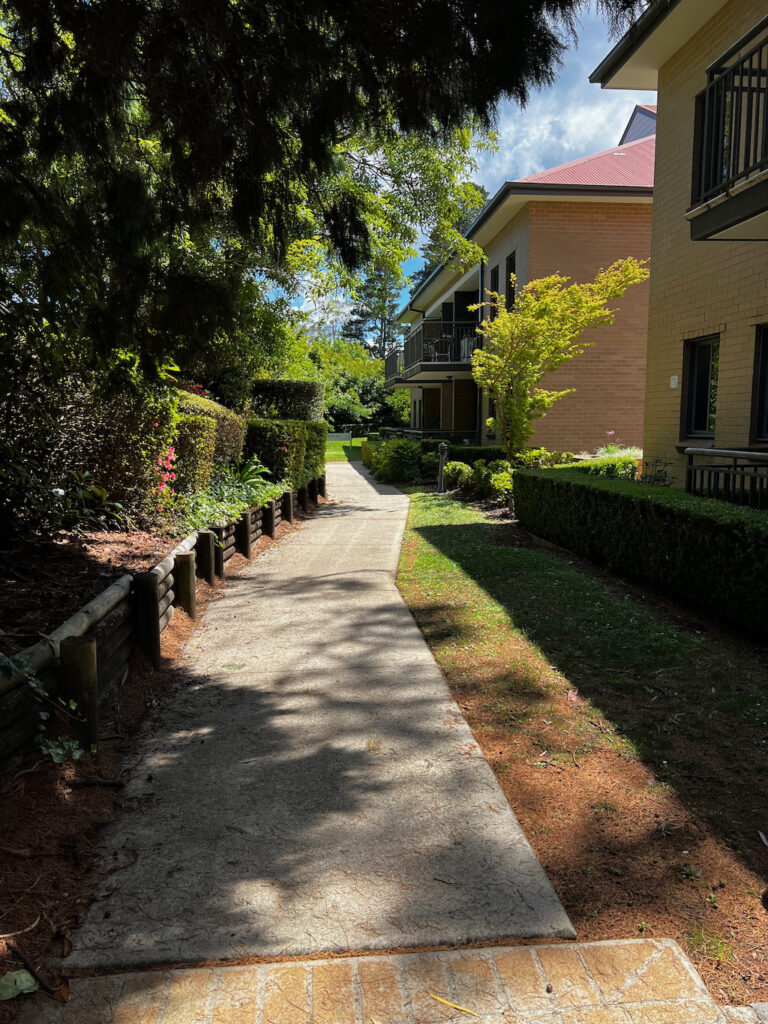
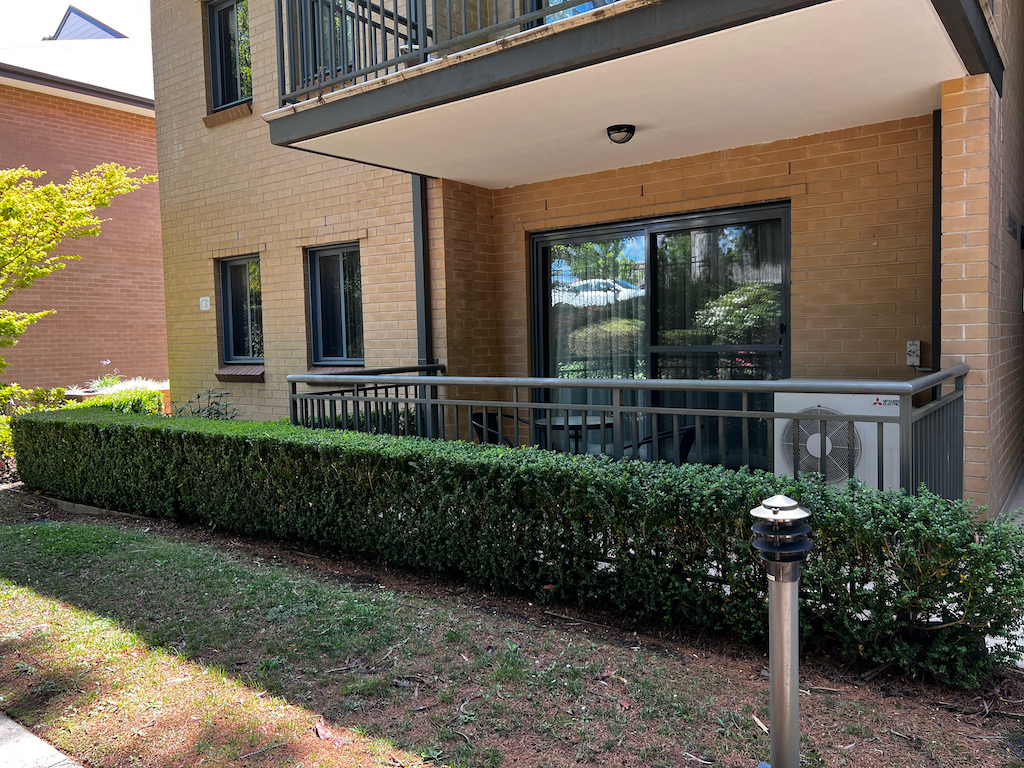
- Bethany Manor B&B call them for Guaranteed Cheapest Price
- Leura House
- Leura Gardens Resort
- Lemon Tree Cottage
- Mintie Cottage on Leura Mall
- Little Haven Leura Cottage with Spa Bath and BBQ
- Holley House
- Bryn-y-Mor Cottage Romantic Fireplace Couples
- Haven Hideaway
- La Casétta
- Azalea Cottage, Leura NSW Australia
- Sublime Cedar Lodge Leura
- Rustic Queen of Leura
- Little Pomander
- Mountain Home Leura – Perfect Weekend Escape
- Alleura House
- Brigalow Cottage
- Banksia Tops
- Coolabah House
- Clanalpine Retreat Leura
- Casa Leura
- Midholm Studio
- Ammu Lodge
- Nuach cottage – Beautiful Family home in Leura
- Blue Mountains Rhapsody
- Mountain Nest – LEURA
- Edelweiss Leura
- Elmview House in Leura
- Leura Country Cottage
- Shirri Mirri
- Snow Leopard Lodge
- Sunningdale – Perfect Memories
- Nagual Retreat in Leura with views
- Blue Vista
- Blue Mountains Sweet Retreat
- Twenty 2 Abbey
- Blue Mountains Bliss
- Ellengowan In Leura on 2 acres
- Stonelinks House sleeping 12
- Leura Sublime Sunrise
- Highview
- Fairmont Resort & Spa Blue Mountains MGallery by Sofitel
- Hailsham House
- Georgette House in Leura
Frequently Asked Questions
How long is the Valley of the Waters walk?
Explore this 4.4-mile out-and-back trail located near Katoomba, New South Wales. Typically regarded as a challenging
What is the easiest waterfall walk in the Blue Mountains?
So, which Blue Mountains waterfall walk is the easiest? The Charles Darwin Walk is often regarded as one of the easiest in the area! Spanning five kilometres, it’s known for its flat terrain. The walk begins in the town of Wentworth Falls and leads you directly to the waterfall.
What is the easiest walk in the Blue Mountains?
The Charles Darwin Walk is a popular Blue Mountains trail, ideal for those who enjoy a leisurely stroll rather than a strenuous hike. The path includes boardwalks over creeks and around ancient trees, as well as bush tracks that wind through open forests and shrubbery.
Is it safe to hike Blue Mountains alone?
The Blue Mountains see more than one search and rescue operation every week, which is why the police have partnered with land managers to create TREK (Think Before You Trek). We strongly advise against hiking alone in this area.
How many days do you need in the Blue Mountains?
The mountains are close enough to Sydney for a day trip, offering a glimpse of the region, but spending a full weekend is ideal to fully experience all it has to offer.
What is the best time to visit the Blue Mountains?
In late spring, around October and November, you’ll enjoy warm, dry conditions for bushwalking. Late autumn, around May, and the winter months can also deliver good bushwalking weather. Don’t miss: The Blue Mountains’ many cool-climate gardens, which light up with colourful leaves in autumn and bright blooms in spring.
If you found this article valuable, you’ll probably find my other works equally captivating.
FOLLOW ME on Facebook, Instagram, Pinterest, Tik Tok, You Tube and Twitter to see more delicious food and get all the latest updates.
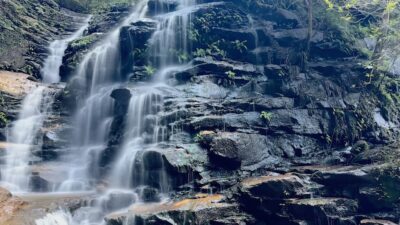
 Discovering the Majestic Wentworth Falls in the Blue Mountains
Discovering the Majestic Wentworth Falls in the Blue Mountains
Leave a Reply